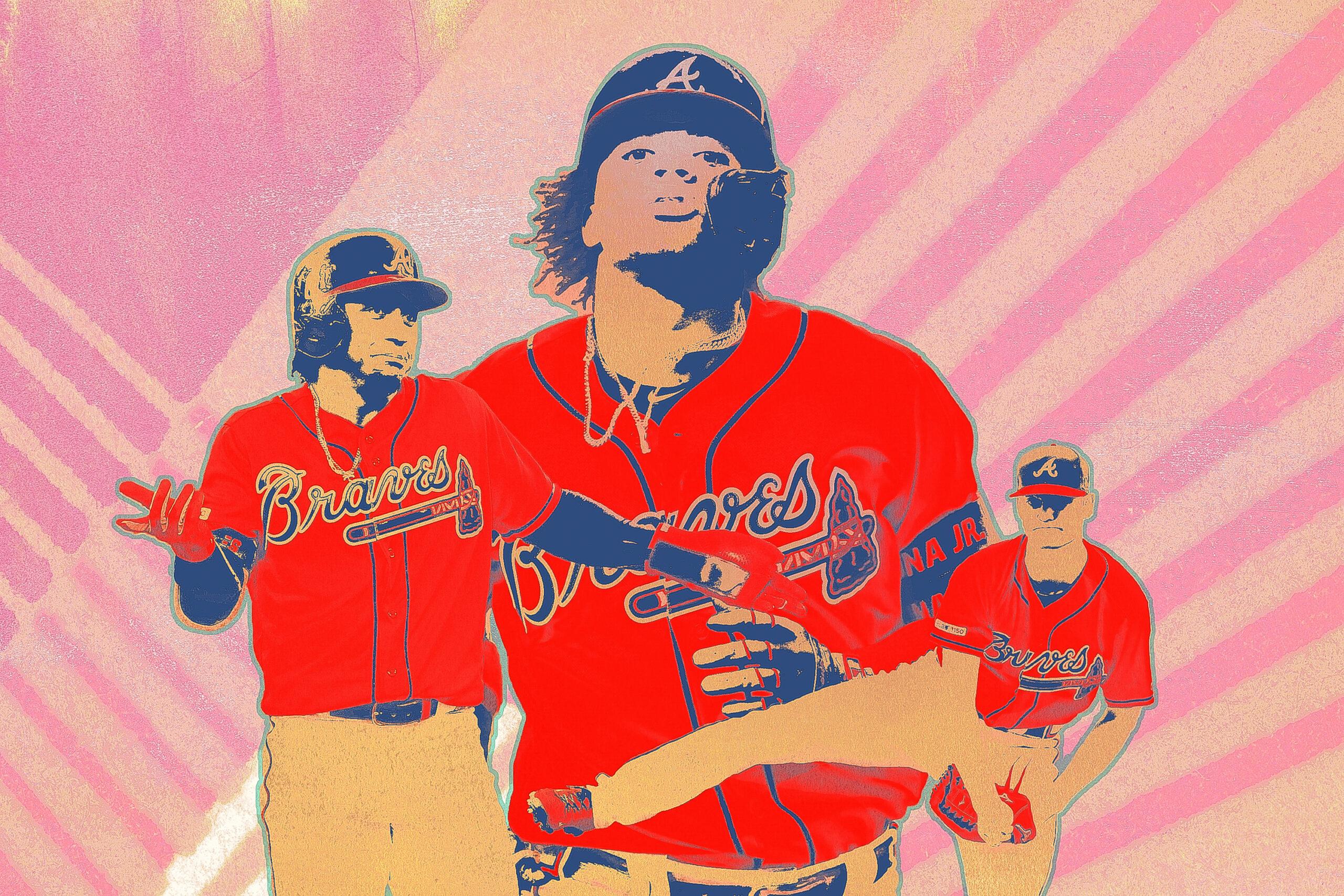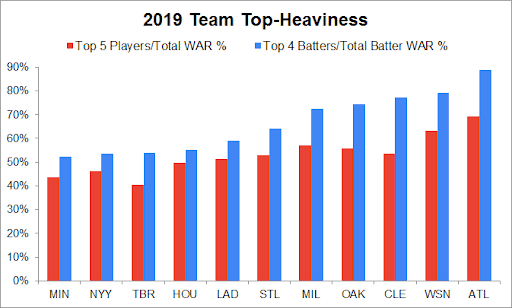
If there was one day when it dawned on baseball observers that the Braves were rebuilt, it was May 1, 2018, when Atlanta took on the Mets in New York. The first two Braves batters that Mets starter Noah Syndergaard saw were Ozzie Albies and Ronald Acuña Jr. Albies singled, Acuña doubled, and both scored on a double by the third batter, Freddie Freeman. When Mets leadoff man Asdrúbal Cabrera batted in the bottom of the first, he faced Mike Soroka, who was making his major league debut. Soroka got Cabrera to ground out and, with help from Albies’s brilliant glove, stayed in through the sixth inning, holding the Mets to one run and striking out five without walking a batter.
Soroka and Acuña, who was then less than one week removed from his own inaugural game, were 20 years old. Albies was 21. They were the three youngest players in the majors, and they were already really good. The baseball world began buzzing about the “Baby Braves,” and the buzz only built as Atlanta went on to win 90 games and an NL East title while finding roles on the roster for eight players who were 22 or younger.
This year’s Braves repeated as NL East champions, bringing the franchise back-to-back division titles for the first time since its record run of 14 consecutive titles came to a close after 2005. As good as Acuña, Albies, and Soroka (who missed much of last season with shoulder woes) were in 2018, the trio collectively doubled its Baseball-Reference WAR total this season, from 7.9 to 16.0. That production helped power the team to 97 wins, and it also helped the Braves boast an unprecedented pairing of elite-level youth. The Braves are the first team to feature three players 22 or younger who were worth more than 4.5 WAR: Soroka (5.6), Acuña (5.5), and Albies (4.8, although he had cleared 5.0 also before going 2-for-14 in his last three games). Only one previous club collected three 22-or-younger players who finished over 4.0 WAR: the 1970 Reds, who earned the first postseason appearance by the Big Red Machine.
The Braves would like to be at the beginning of an extended, Reds-like run of success. In April, they locked up Acuña and Albies to team-friendly, long-term extensions that could keep the two stars in Atlanta through 2028 and 2027, respectively, in the likely event that the Braves exercise their options at the end of the deals. Acuña, who finished three stolen bases short of a 40-40 season, is both the best and the best-known of the Braves’ precocious building blocks; his all-around excellence and demonstrative style landed him a central role in MLB’s just-released “We Play Loud” postseason promo. Acuña slaps his chest in the Twitter background image displayed before the viewer presses play; he hits a virtual home run off of Bullet Bob Turley on a swing spliced with footage from the 1960 World Series; and in the closing clip, he rounds the bases after walking off an August game against the Marlins. He’s already made more postseason plate appearances than Mike Trout, and in the Angel’s absence, he’s October’s most riveting five-tool talent.
Acuña’s power/speed sorcery and the success of the Braves’ breakout trio have propelled Atlanta back to the top of the NL East, which is what then-president John Schuerholz had in mind when he pulled the plug on a weakening core after the 2014 season. The Braves had won the East in 2013, extended multiple players prior to 2014 Opening Day, and led the division again as late as July 20 of that year, but they went .500 in July and August and slumped to 7-18 in September, which convinced Schuerholz that their window was closed and doomed GM Frank Wren, who was axed on September 22. Schuerholz and Wren’s successors, the executive tandem of John Hart and John Coppolella, then orchestrated a series of trades that sent Jason Heyward, Justin Upton, Craig Kimbrel, Shelby Miller, Andrelton Simmons, and others out of town and brought back prospects who soon restocked the system.
The Braves didn’t get good again by 2017, when they had hoped to field a club that could bring attention to brand-new SunTrust Park, but they didn’t miss by much: After three seasons of sitting between 67 and 72 wins, they climbed back to the top last year. Oddly, though, this Braves team doesn’t look like the one Schuerholz built in the ’90s, even though he, Hart, and Coppolella tried to assemble it the same way. The rebuild worked, but not quite the way it was intended to. This Braves team has no shortage of young pitching, but it’s still an offense-centric team—and, for now, a top-heavy one that depends heavily on its 22-and-under phenoms, one holdover drafted during Schuerholz’s last year as GM (Freddie Freeman), and one wise one-year signing (Josh Donaldson).
Beginning in 1993, when Greg Maddux arrived to complete the Maddux-Glavine-Smoltz trifecta, the Braves finished first in the majors in pitching WAR for eight consecutive seasons. Their average rank in batter WAR over the same span was 6.5; when they won the World Series in 1995 and took home two more pennants in 1996 and 1999, their batter WAR totals ranked 14th, fifth, and 11th, respectively. This time around, the formula has flipped. Since the start of last season, the Braves have ranked sixth in batter WAR but only 16th in pitcher WAR.
That’s not for lack of acquiring arms. “Borrowing the franchise’s rebuilding blueprint from the late 1980s, the Braves are stockpiling pitching,” the Baseball America Prospect Handbook said in 2016, somewhat understating the case. In addition to targeting pitching prospects such as Sean Newcomb, Max Fried, and Touki Toussaint in trades, the Braves treated the draft as a pitcher emporium.
In 2015, the Braves used their top two draft picks on pitchers (one of whom was Soroka), as well as 11 of their 13 picks in the first 10 rounds and 20 of their first 26 picks overall. The next June, they drafted pitchers with their top three picks and seven of their 12 picks in the first 10 rounds. And in 2017, they selected pitchers with their top pick and seven of their 10 picks in the first 10 rounds. All told, the Braves used 25 of their 35 picks (71.4 percent) in the first 10 rounds from 2015 to 2017 on pitchers, second only to the 72.4 percent expended by the Cubs, who’ve extracted hardly any value from their homegrown arms. No other team picked pitchers more than 63.6 percent of the time. By early 2016, the Braves had baseball’s youngest rotation, although it was also one of the worst.
Still, all of that trading and drafting paid off below the big leagues. In early 2017, the new edition of BA’s Prospect Handbook declared, “The second-worst farm system in baseball two years ago is now the best in the game.” The handbook also noted that “The system is built around a deep wave of pitching.” Yet some of that pitching had already run into trouble. In the middle of the 2016 season, columnist Mark Bradley had asked Coppolella about a few pitching prospects who had suffered injuries or seemed to stagnate developmentally. “The fact that so many of these pitchers get hurt is precisely why we are building around pitching,” the GM said. “There’s so much attrition associated with pitching that you truly can never have enough talent or depth when it comes to arms. … We won’t feel our pitching is good enough until we can run out our own version of Maddux-Glavine-Smoltz, and we’ve still got a long way to go.”
Recreating that Cerberus of a starting rotation would have been a tall order for any organization, but the Braves haven’t come closer than Soroka, Fried, and Julio Teheran. Of course Coppolella didn’t last long enough to see Soroka’s debut. The GM resigned in October 2017 amid an MLB investigation into the Braves’ amateur signing practices; that November, Hart departed too, and Coppolella was permanently banned from baseball. A regime change didn’t derail the Braves’ progress in the standings, but the team is still searching for stability on the pitching side.
Aside from Soroka, Fried, and Teheran—who’s made at least 30 starts in every season since 2013, but struggled in his final few outings of the regular season and was left off the NLDS roster—the staff has been cobbled together with outside additions and inconsistent products of the Coppolella-led rebuild. Mike Foltynewicz, whom the Braves acquired in the 2015 Evan Gattis trade, was an All-Star last year but struggled early this season and spent July in the minors. He’s been far more effective since his August return and will get the Game 2 start, following series opener Dallas Keuchel, a midseason free-agent addition. Newcomb, the prospect centerpiece of the Simmons trade, has moved to the bullpen, which was reconfigured on the fly: The Braves added Josh Tomlin, Anthony Swarzak, and Jerry Blevins either just before or soon after the start of the season, and as the trade deadline loomed, they acquired Shane Greene, Mark Melancon, and Chris Martin. The latter three cost them two of their 2015-16 first-round arms, Kolby Allard and Joey Wentz, as well as 2018 fourth-rounder Tristan Beck. Newcomb is the only homegrown guy in the playoff pen.
The upshot is that a Braves team that was supposed to be built on homegrown pitching looks a little light on arms. Yet the team is still where it wanted to be, because Albies and Acuña have panned out beyond the Braves’ wildest dreams, Freeman remains a force in the middle of the lineup, and Donaldson, who signed a one-year, $23 million deal last November after an injury-plagued season with Toronto and Cleveland, has roughly regained his MVP form. Acuña and Freeman nursed nagging injuries late in the regular season, but both are reportedly ready to go in Game 1.
The Braves will need them: This year, the club derived 20.8 of its 23.4 batter WAR (88.9 percent) from those top four batters, and 26.3 of its 38.0 overall WAR (69.2 percent) from its top five players (including Soroka). Of the 298 teams that have ever won 95 games or more, only 13 received a higher percentage of their batter WAR from their top four batters, and only 27 received a higher percentage of their total WAR from their top five players. Among the 2019 teams that won more than 86 games, Atlanta’s top-heaviness in both respects stands out.

Speaking to Jayson Stark this week, Braves third-base coach Ron Washington acknowledged that the Braves are a stars-and-scrubs unit, saying that when he talks to most members of the team, “I put it in a way like this: ‘We’ve got this big yellow bus, and there’s about four driver’s seats—and none of you all sit in the driver’s seat. You’re all passengers.’ And they all know that. They’re passengers. One day, the rest of ’em, they’ll get a chance to drive.”
It’s not necessarily bad to be built that way, because it suggests that there’s room to improve—a happy prospect for a team that’s already reached its regular-season goals. Thus far, it looks like the best decisions Hart and Coppolella made were the ones not to trade Acuña, Albies, and Freeman. Even factoring in Freeman, the Braves rank in the middle of the pack in WAR produced by drafted players, but they’re close to the top in WAR generated by amateur free agents, a category that includes Acuña and Albies. The Braves stockpiled pitching because pitching prospects are unpredictable, and their rebuild proves the point.
Acuña, Albies, and Dansby Swanson are the only under-30 members of Atlanta’s projected playoff lineup (which won’t include 22-year-old Austin Riley), but on average, the Braves had the youngest pitching staff of any contending team in 2019. For every failed and departed pitching prospect like Matt Wisler, Lucas Sims, Aaron Blair, and Luiz Gohara, there’s another—Ian Anderson, Toussaint, Kyle Wright, Bryse Wilson—waiting in the wings and hoping for a smoother acclimation to the majors. Maybe some of them will learn to drive; if they do, the Braves should contend for many more NL East titles.
If there’s a lesson in Atlanta’s path to the playoffs, it’s that no multiyear roster teardown and buildup pans out perfectly (except, perhaps, for the Astros’). The Cubs built around position players, but their inability to develop pitchers eventually knocked them off course. The Braves built around pitchers and stumbled themselves, but when their reconstructed staff fell far short of ’90s dominance, Acuña and Albies bailed them out. (Acuña ranked just 26th in the Braves system in 2016, according to BA, because he projected to be “more of a gap-to-gap hitter,” so maybe no one knows anything.) As Atlanta’s enviable young core and improvised rest of the roster returns to the division series, no one will be worrying about the blueprint from five years ago. One way or another, rebuilding brought the Braves back to October, and for the fans who were promised a perennial playoff team, that’s the important part.
Thanks to Kenny Jackelen of Baseball-Reference and Lucas Apostoleris of Baseball Prospectus for research assistance.

